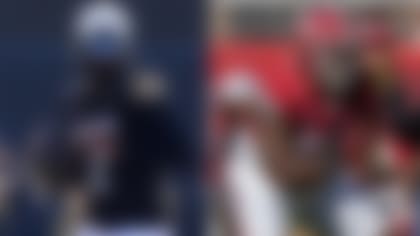INDIANAPOLIS -- The role played by the New York Giants' 2007 rookie class during their successful Super Bowl run has not gone unnoticed. At the NFL Scouting Combine, an annual gathering of front office personnel, opposing scouts have recognized the contributions of the Giants' young talent.
"You can get players two ways -- through the draft and through free agency," said Bears director of college scouting Greg Gabriel, who was a Giants scout for 16 seasons. "They've done very well in the draft. They've got young guys who come in and contribute, which is a testament to their scouting system."
What a difference a season makes. Last year at this time, Tom Coughlin was clinging to his coaching life. This week he's returned to the combine as the toast of the NFL coaching fraternity, looking to repeat the Giants' draft success from last season. Read more...
As a scout and later director of player personnel for the Giants since 1996, Jerry Reese feels right at home at the combine.
"I'm a scout," he said. "Raised as a scout. Once a scout you're always a scout. You always have that in your blood."
Reese said he's received a lot of recognition from his peers for the way this particular Giants team was crafted.
"The scouts like that," he said. "They like when you go into the draft and really listen to your scouts and draft the right players. And then the fruit of the victory -- they like seeing that happen. So I've gotten several comments from colleagues and scouts and personnel people saying, 'Man you guys picked the players and played them -- picked 'em and played 'em.' "
But that formula is not always followed in today's NFL, where many coaches prefer to rely on veterans and high-priced free agents to fill out their starting lineups. The Giants were one team that looked to their own drafted talent down the stretch, especially when key starters such as Jeremy Shockey and Sam Madison went down with injuries.
"We had to play a lot of rookies because a lot of stuff didn't work out for us in free agency last year," Reese said. "Part of it was because we didn't want it to work, and part of it was because it wasn't the right time for us to make some moves in free agency. We went after some guys and it didn't work out. So we had some rookies that had to play. It's a testament to our coaching staff to get the guys ready, and they did."
It is also a testament to the work done by team scouts leading up to the April draft.
Reese noted that rookie contributors such as tight end Kevin Boss and running back Ahmad Bradshaw probably would not have been drafted had it not been for the due diligence of the Giants' scouting team.
"Actually," said Reese, "(Boss) wasn't even on our list initially, and one of our scouts heard about him or saw him in a game. You know who fought for Kevin Boss the most is Mike Pope, our tight ends coach," said Reese, noting that a shoulder injury suffered by Boss forced the Giants to at first shy away from the tight end out of Division II Western Oregon.
"(After the combine) we didn't have enough information on him," Pope said of Boss. "We needed to work him out individually. He was better, but not 100 percent, but we were able to do more. For his size at 6-foot-7, he had a high amount of agility, and he had the ability to unload the hips. He was a basketball player, too, which means he had good athleticism."
Pope noted the challenge in scouting small-school talents such as Boss.
"(It can be difficult) because the quality of tapes in small schools are not as good as those from bigger schools, where games can have a number of different camera angles," said Pope. "It takes a lot of research to take (small-school) players that deep in the draft."
In Bradshaw's case, Reese said certain off-the-field questions regarding the running back from Marshall probably caused him to drop to the last round of the draft.
"The commissioner came down heavy on off-the-field conduct, and I think that scared some people off," said Reese. "He had a couple issues that were well documented, so I think that's why he stayed on the board as long as he did. Because we had a middle-round grade on him.
"So we have this little guy that we have a nice grade on. One issue was underage drinking on a recruiting trip, or something like that. I was like, 'Nobody's in the room here if we kill him for that.' "
The Giants did as much research as they could, making some extra phone calls to associates at Marshall. On draft day they took a risk on Bradshaw, using their eighth pick to take him. Bradshaw repaid the team with 151 rushing yards in a playoff-clinching performance against Buffalo in Week 16, as well as 208 rushing yards and one touchdown as a change-of-pace back in four playoff games.
"You've got to dig. It takes a lot of work," said Gabriel of researching players' personalities and histories off the field. "You're not just talking to one or two guys at the school, you're talking to eight or nine or 10 people at the school. Maybe you go back to his high school. Maybe you're talking to campus security. There are a number of people. And you find if you've got your scouts going to the same schools year after year, they're going to build connections at the school. They're going to find information you can trust and give you accurate information. Then you go from there."
Reese felt confident enough with the information the Giants scouting team compiled on Bradshaw to take a chance.
The Giants drafted Boss and Bradshaw on the second day of the draft, a time when Reese says good research can lead to valuable draft choices.
"Your first three picks, everybody thinks those guys have to be able to come in and contribute in some way," said Reese. "You might even get a couple starters out of your first three picks. But the back side of your draft, we always talk about, this is where we really make our money, because we have to get some diamonds out of the rough on the backside, and we were able to do that."



